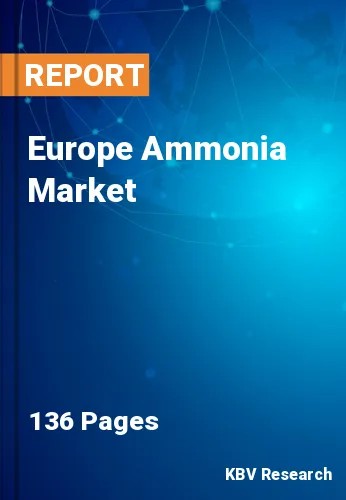The Europe Ammonia Market would witness market growth of 6.0% CAGR during the forecast period (2023-2030). In the year 2020, the Europe market's volume surged to 20,580.1 Kilo Tonnes, showcasing a growth of 4.1% (2019-2022).
The fertilizer companies' increasing need for ammonia is anticipated to spur market expansion. The product serves as the foundation for the global nitrogen sector. Ammonia is a gas that is colorless, extremely unpleasant and has a pungent, choke-inducing stench. It creates a solution of ammonium hydroxide, which dissolves readily in water. Burns and discomfort may result from the solution. The gas is easily squeezed, and under pressure, it turns into clear, colorless liquids. It is often carried as a compressed fluid in a cylindrical shape. It is also not very explosive, but it could explode when subjected to extreme heat.
Ammonia is a processing aid utilized in producing various products for fermenting and growth control systems in biotechnology. Ammonia, used extensively in the pharmaceutical business, is created when the gas version of ammonium is mixed with water. It is produced for sale using the Haber-Bosch method. Temperature increase, a catalyst, and hot temperatures are all present during the process, which involves a direct interaction between atomic hydrogen and nitrogen. The process can use various catalytic materials, including aluminum oxide, magnesium oxide, and iron oxide. It is created in a lab setting by hydrolyzing a metal nitride.
According to the government of the UK, in 2022, agriculture's contribution to the UK economy (Gross Value Added at basic prices) was £13.9 billion (0.6% of GDP). This constitutes an increase of £1.8 billion (15%) in GVA compared to 2021. And total crop output increased by £2.4 billion (22%) from 2021 to £13.3 billion. As the agriculture industry in the UK continues to grow, there is a concurrent increase in the demand for ammonia-based fertilizers. These fertilizers, including ammonium nitrate and urea, are essential for optimizing crop yields and promoting plant growth. The UK produces various crops, including cereals (wheat and barley), oilseeds, fruits, vegetables, and potatoes. These crops benefit significantly from applying ammonia-based fertilizers to improve soil fertility and productivity. The aforementioned factors raise the expansion of the market in this region.
The Russia market dominated the Europe Ammonia Market, By Country in 2022, and would continue to be a dominant market till 2030; thereby, achieving a market value of $14,207.4 million by 2030. The France market is experiencing a CAGR of 4.6% during (2023 - 2030). Additionally, The Germany market would exhibit a CAGR of 7.3% during (2023 - 2030).
Based on Product Form, the market is segmented into Anhydrous, and Aqueous. Based on Application, the market is segmented into Fertilizers, Refrigerants, Pharmaceuticals, Textile, and Others. Based on countries, the market is segmented into Russia, France, Germany, UK, Spain, Italy, and Rest of Europe.
Free Valuable Insights: The Global Ammonia Market will Hit $306.7 Billion by 2030, at a CAGR of 5.6%
The market research report covers the analysis of key stake holders of the market. Key companies profiled in the report include SABIC (Saudi Arabian Oil Company), Linde PLC, Yara International ASA, Nutrien Limited, BASF SE, Sumitomo Chemical Co., Ltd., Koch Industries, Inc. (Molex LLC), CF Industries Holdings, Inc., Qatar Fertiliser Company (Industries Qatar), and PJSC Togliattiazot.
By Product Form (Volume, Kilo Tonnes, USD Million, 2019-2030)
By Application (Volume, Kilo Tonnes, USD Million, 2019-2030)
By Country (Volume, Kilo Tonnes, USD Million, 2019-2030)
Our team of dedicated experts can provide you with attractive expansion opportunities for your business.

